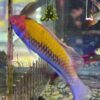Dragons and Their Influence in Classical Chinese Paintings
The dragon (龙, lóng) has been one of the most revered and influential symbols in Chinese culture for thousands of years. Unlike the fire-breathing monsters of Western mythology, the Chinese dragon is a benevolent, celestial creature associated with wisdom, power, and prosperity. This legendary being has played a significant role in classical Chinese paintings, reflecting cultural beliefs, imperial authority, and philosophical ideals.
From ancient murals to delicate ink paintings, the depiction of dragons in Chinese art evolved through various dynasties, each adding unique characteristics and artistic techniques. This article explores the history, styles, and symbolism of dragons in classical Chinese paintings, highlighting their profound influence on artistic traditions.
1. Origins of Dragons in Chinese Art
a. Early Depictions: Neolithic and Shang Dynasty (5000 BCE – 1046 BCE)
The earliest artistic representations of dragons can be traced back to the Neolithic period, appearing on jade carvings, pottery, and ritual artifacts.
- The Hongshan culture (4700–2900 BCE) produced jade dragon sculptures, signifying spiritual protection.
- The Shang Dynasty (1600–1046 BCE) featured dragons on bronze vessels and oracle bone scripts, indicating their role in religious rituals and divine communication.
These early depictions were stylized and abstract, focusing on serpentine forms and curved lines to represent the dragon’s connection to nature and the cosmos.
b. The Zhou and Han Dynasties (1046 BCE – 220 CE): The Rise of Ink Drawings
During the Zhou Dynasty, dragons became closely linked with emperors and cosmic order, reinforcing their status as symbols of divine rule.
In the Han Dynasty (206 BCE – 220 CE), the invention of silk scroll painting allowed for more detailed depictions of dragons.
- Han tomb murals featured dragons as guardians of the afterlife, often seen ascending toward the heavens.
- Ink wash techniques began to develop, allowing artists to create fluid, dynamic dragon forms that emphasized their mythical energy.
2. Dragons in Tang Dynasty Paintings (618–907 CE): The Golden Age of Chinese Art
The Tang Dynasty was a flourishing period for Chinese art, during which dragons became more elaborate and refined in paintings.
a. Imperial Dragon Imagery
During this time, dragons became official symbols of imperial power. Emperors, believed to be the “Sons of Dragons,” commissioned paintings that reinforced their divine right to rule.
- The Nine-Dragon Robe, worn by the emperor, inspired numerous silk paintings featuring powerful golden dragons.
- Court painters often depicted dragons soaring through clouds, clutching pearls, symbolizing heavenly wisdom and supreme authority.
b. The Influence of Buddhist and Daoist Art
Dragons were also featured in Buddhist and Daoist paintings, symbolizing protection, enlightenment, and cosmic balance.
- Daoist temples featured murals of dragons controlling rain, reflecting their role as nature’s guardians.
- Buddhist scrolls depicted dragons paying homage to the Buddha, emphasizing their spiritual significance.
One famous painting from this era is the Dragon and Tiger Mural, found in the Dunhuang caves, illustrating the duality of power and wisdom.
3. Song Dynasty (960–1279 CE): The Peak of Dragon Ink Paintings
The Song Dynasty marked a turning point in Chinese art, emphasizing naturalism, simplicity, and philosophical depth.
a. The Mastery of Ink Wash Painting
Artists like Chen Rong (陈容) became famous for their free-flowing, expressive dragon paintings, using:
- Bold brushstrokes to depict energy and movement.
- Mist and clouds to create a sense of mystery and divinity.
One of the most celebrated works from this period is “Nine Dragons” (九龙图) by Chen Rong (1244 CE).
- This handscroll portrays nine dragons swirling through clouds, each with unique expressions and postures.
- The painting captures the dynamic power and spontaneity of dragons, making it an iconic masterpiece of Chinese ink painting.
b. Scholar Paintings and Daoist Influence
In addition to imperial commissions, scholars and Daoist painters began using dragons to symbolize wisdom and transformation.
- Unlike earlier court paintings, these dragons were often more abstract, blending into misty landscapes.
- They reflected Taoist principles of flow and harmony, emphasizing balance between power and restraint.
4. Yuan and Ming Dynasty (1271–1644): Dragons as a Cultural and Political Symbol
The Yuan Dynasty (1271–1368) and Ming Dynasty (1368–1644) saw further evolution in dragon paintings, influenced by both Mongol rule and Chinese revivalism.
a. Dragons in Court Paintings
During the Ming period, dragons were painted in bold colors with intricate details, often featured on:
- Imperial banners and scrolls, reinforcing their connection to the emperor.
- Tomb paintings, where dragons guided spirits into the afterlife.
One significant painting from this period is “Ascending Dragon”, symbolizing an emperor’s divine ascension and ultimate power.
b. Dragons in Decorative Art
During the Ming Dynasty, dragons were not only painted on silk but also appeared on:
- Blue-and-white porcelain, featuring elegantly coiled dragons amid waves and clouds.
- Embroidered silk paintings, where golden dragons adorned imperial robes and palace decorations.
These artistic traditions continued into the Qing Dynasty (1644–1912), solidifying the dragon’s presence in imperial and cultural identity.
5. Dragons in Classical Chinese Landscape Paintings
One of the most unique aspects of Chinese dragon paintings is their integration into landscape art.
- Many Shan Shui (山水) paintings (mountain and water paintings) subtly depict dragons hidden within mountains, rivers, or clouds.
- These works emphasize the Daoist belief that dragons are part of nature’s energy, blending seamlessly with the environment.
For example, in the painting “Dragon Emerging from Mist”, the artist skillfully integrates a dragon within rolling clouds, reinforcing its mystical and ethereal nature.
6. The Legacy of Dragons in Classical Chinese Paintings
Even after the Qing Dynasty, dragon paintings remained a central theme in Chinese art, influencing:
- Modern ink painting techniques.
- Martial arts and fantasy illustrations in contemporary Chinese culture.
- Chinese calligraphy, where brush strokes mimic the flow and power of dragon movements.
Today, dragons continue to be painted, embroidered, and sculpted, maintaining their timeless presence in Chinese artistic traditions.
Conclusion
Dragons have played an extraordinary role in classical Chinese paintings, evolving from early ritual symbols to sophisticated imperial and philosophical icons.
- In Han Dynasty murals, they were depicted as cosmic guardians.
- In the Tang Dynasty, they became imperial emblems.
- In Song Dynasty ink paintings, they symbolized fluidity and artistic mastery.
- In the Ming and Qing Dynasties, they became more decorative and elaborate.
Through centuries of artistic evolution, dragons have remained a timeless representation of wisdom, power, and spiritual harmony, leaving an indelible mark on Chinese artistic heritage.


